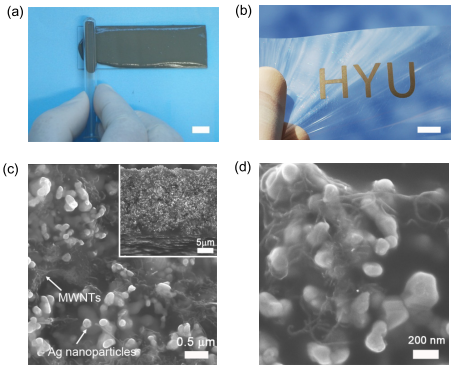 Kyoung-Yong Chun1, Shi Hyeong Kim1, Min Kyoon Shin1, Youn Tae Kim2, Geoffrey M Spinks3, Ali E Aliev4, Ray H Baughman4 and Seon Jeong Kim1
Kyoung-Yong Chun1, Shi Hyeong Kim1, Min Kyoon Shin1, Youn Tae Kim2, Geoffrey M Spinks3, Ali E Aliev4, Ray H Baughman4 and Seon Jeong Kim1
1 Center for Bio-Artificial Muscle and Department of Biomedical Engineering, Hanyang University, Seoul 133-791, Korea
2 IT Fusion Technology Research Center and Department of IT Fusion Technology, Chosun University, Gwangju 501-759, Korea
3 ARC Centre of Excellence for Electromaterials Science, Intelligent Polymer Research Institute, University of Wollongong, Wollongong, NSW 2522, Australia
4 The Alan G MacDiarmid NanoTech Institute, University of Texas at Dallas, Richardson, TX 75083, USA
*Corresponding author.E-mail: sjk@hanyang.ac.kr.
원문 링크 : http://www.sciencemag.org/content/343/6173/868.short
Abstract
The prospect of electronic circuits that are stretchable and bendable promises tantalizing applications such as skin-like electronics, roll-up displays, conformable sensors and actuators, and lightweight solar cells. The preparation of highly conductive and highly extensible materials remains a challenge for mass production applications, such as free-standing films or printable composite inks. Here we present a nanocomposite material consisting of carbon nanotubes, ionic liquid, silver nanoparticles, and polystyrene–polyisoprene–polystyrene having a high electrical conductivity of 3700 S cm−1 that can be stretched to 288% without permanent damage. The material is prepared as a concentrated dispersion suitable for simple processing into free-standing films. For the unstrained state, the measured thermal conductivity for the electronically conducting elastomeric nanoparticle film is relatively high and shows a non-metallic temperature dependence consistent with phonon transport, while the temperature dependence of electrical resistivity is metallic. We connect an electric fan to a DC power supply using the films to demonstrate their utility as an elastomeric electronic interconnect. The huge strain sensitivity and the very low temperature coefficient of resistivity suggest their applicability as strain sensors, including those that operate directly to control motors and other devices.